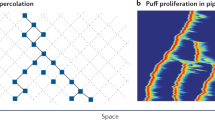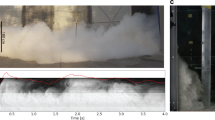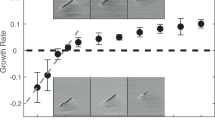Abstract
The onset of turbulence in pipe flow has defied detailed understanding ever since the first observations of the spatially heterogeneous nature of the transition. Recent theoretical studies and experiments in simpler, shear-driven flows suggest that the onset of turbulence is a directed-percolation non-equilibrium phase transition, but whether these findings are generic and also apply to open or pressure-driven flows is unknown. In pipe flow, the extremely long time scales near the transition make direct observations of critical behaviour virtually impossible. Here we find a technical solution to that limitation and show that the universality class of the transition is directed percolation, from which a jammed phase of puffs emerges above the critical point. Our method is to experimentally characterize all pairwise interactions between localized patches of turbulence puffs and use these interactions as input for renormalization group and computer simulations of minimal models that extrapolate to long length and time scales. The strong interactions in the jamming regime enable us to explicitly measure the turbulent fraction and confirm model predictions. Our work shows that directed-percolation scaling applies beyond simple closed shear flows and underscores how statistical mechanics can lead to profound, quantitative and predictive insights on turbulent flows and their phases.
This is a preview of subscription content, access via your institution
Access options
Access Nature and 54 other Nature Portfolio journals
Get Nature+, our best-value online-access subscription
$32.99 / 30 days
cancel any time
Subscribe to this journal
Receive 12 print issues and online access
$259.00 per year
only $21.58 per issue
Buy this article
- Purchase on SpringerLink
- Instant access to full article PDF
Prices may be subject to local taxes which are calculated during checkout





Similar content being viewed by others
Data availability
All experimental data presented in this article are available online in the Zenodo repository at https://doi.org/10.5281/zenodo.10308791 (ref. 37).
Code availability
All computational data presented in this paper, the codes used to generate and process those data and the codes and scripts used to generate the figures are available online in the Zenodo repository at https://doi.org/10.5281/zenodo.10308791 (ref. 37).
References
Reynolds, O. An experimental investigation of the circumstances which determine whether the motion of water shall be direct or sinuous and the law of resistance in parallel channel. Philos. Trans. R. Soc. Lond. 174, 935 (1883).
Rotta, J. Experimenteller beitrag zur entstehung turbulenter strömung im rohr. Ing.-Arch. 24, 258–281 (1956).
Wygnanski, I. J. & Champagne, F. On transition in a pipe. Part 1. The origin of puffs and slugs and the flow in a turbulent slug. J. Fluid Mech. 59, 281–335 (1973).
Shimizu, M. & Kida, S. A driving mechanism of a turbulent puff in pipe flow. Fluid Dyn. Res. 41, 045501 (2009).
Tuckerman, L. S., Chantry, M. & Barkley, D. Patterns in wall-bounded shear flows. Annu. Rev. Fluid Mech. 52, 343–367 (2020).
Avila, M., Barkley, D. & Hof, B. Transition to turbulence in pipe flow. Annu. Rev. Fluid Mech. 55, 575–602 (2023).
Song, B. & Hof, B. Deterministic and stochastic aspects of the transition to turbulence. J. Stat. Mech. Theory Exp. 2014, P02001 (2014).
Manneville, P. On the transition to turbulence of wall-bounded flows in general, and plane Couette flow in particular. Eur. J. Mech. B Fluids 49, 345–362 (2015).
Barkley, D. Theoretical perspective on the route to turbulence in a pipe. J. Fluid Mech. 803, P1 (2016).
Pomeau, Y. The long and winding road. Nat. Phys. 12, 198–199 (2016).
Goldenfeld, N. & Shih, H.-Y. Turbulence as a problem in non-equilibrium statistical mechanics. J. Stat. Phys. 167, 575–594 (2017).
Avila, K. et al. The onset of turbulence in pipe flow. Science 333, 192–196 (2011).
Pomeau, Y. Front motion, metastability and subcritical bifurcations in hydrodynamics. Physica D 23, 3–11 (1986).
Chaté, H. & Manneville, P. Transition to turbulence via spatio-temporal intermittency. Phys. Rev. Lett. 58, 112 (1987).
Moxey, D. & Barkley, D. Distinct large-scale turbulent-laminar states in transitional pipe flow. Proc. Natl Acad. Sci. USA 107, 8091–8096 (2010).
Sipos, M. & Goldenfeld, N. Directed percolation describes lifetime and growth of turbulent puffs and slugs. Phys. Rev. E 84, 035304 (2011).
Barkley, D. Simplifying the complexity of pipe flow. Phys. Rev. E 84, 016309 (2011).
Shi, L., Avila, M. & Hof, B. Scale invariance at the onset of turbulence in Couette flow. Phys. Rev. Lett. 110, 204502 (2013).
Shih, H.-Y., Hsieh, T.-L. & Goldenfeld, N. Ecological collapse and the emergence of travelling waves at the onset of shear turbulence. Nat. Phys. 12, 245 (2016).
Chantry, M., Tuckerman, L. S. & Barkley, D. Universal continuous transition to turbulence in a planar shear flow. J. Fluid Mech. 824, R1 (2017).
Lemoult, G. et al. Directed percolation phase transition to sustained turbulence in couette flow. Nat. Phys. 12, 254–258 (2016).
Klotz, L., Lemoult, G., Avila, K. & Hof, B. Phase transition to turbulence in spatially extended shear flows. Phys. Rev. Lett. 128, 014502 (2022).
Goldenfeld, N. Lectures on Phase Transitions and the Renormalization Group (Addison-Wesley, 1992).
Dauchot, O. & Bertin, E. Subcritical transition to turbulence: what we can learn from the physics of glasses. Phys. Rev. E 86, 036312 (2012).
Hof, B., De Lozar, A., Avila, M., Tu, X. & Schneider, T. M. Eliminating turbulence in spatially intermittent flows. Science 327, 1491–1494 (2010).
Mukund, V. & Hof, B. The critical point of the transition to turbulence in pipe flow. J. Fluid Mech. 839, 76–94 (2018).
Barkley, D. et al. The rise of fully turbulent flow. Nature 526, 550 (2015).
Kreilos, T. et al. Bypass transition and spot nucleation in boundary layers. Phys. Rev. Fluids 1, 043602 (2016).
Wang, X., Shih, H.-Y. & Goldenfeld, N. Stochastic model for quasi-one-dimensional transitional turbulence with streamwise shear interactions. Phys. Rev. Lett. 129, 034501 (2022).
Hinrichsen, H. Non-equilibrium critical phenomena and phase transitions into absorbing states. Adv. Phys. 49, 815–958 (2000).
Helbing, D. Traffic and related self-driven many-particle systems. Rev. Mod. Phys. 73, 1067 (2001).
Klumpp, S. & Hwa, T. Stochasticity and traffic jams in the transcription of ribosomal RNA: Intriguing role of termination and antitermination. Proc. Natl Acad. Sci. USA 105, 18159–18164 (2008).
Kim, S. & Jacobs-Wagner, C. Effects of mRNA degradation and site-specific transcriptional pausing on protein expression noise. Biophys. J. 114, 1718–1729 (2018).
Chatterjee, P., Goldenfeld, N. & Kim, S. DNA supercoiling drives a transition between collective modes of gene synthesis. Phys. Rev. Lett. 127, 218101 (2021).
Lighthill, M. J. & Whitham, G. B. On kinematic waves II. A theory of traffic flow on long crowded roads. Proc. R. Soc. Lond. A 229, 317–345 (1955).
Jensen, I. Low-density series expansions for directed percolation on square and triangular lattices. J. Phys. A 29, 7013–7040 (1996).
Lemoult, G. Directed percolation and puff jamming near the transition to pipe turbulence. Zenodo https://doi.org/10.5281/zenodo.10308791 (2024).
Acknowledgements
We gratefully acknowledge the assistance of J. M. Lopez with DNSs at an early stage of this work. This work was partially supported by two grants from the Simons Foundation (grant nos. 662985 (N.G.) and 662960 (B.H.)) and by Ministry of Science and Technology, Taiwan (grant nos. MOST 109-2112-M-001-017-MY3 and MOST 111-2112-M-001-027-MY3 (H.-Y.S.)). Part of this work was performed using computing resources of CRIANN (Normandy, France).
Author information
Authors and Affiliations
Contributions
B.H., N.G. and J.M. designed the project. B.H., G. Lemoult and V.M. performed experiments and computer simulations. H.-Y.S., G. Linga, J.M. and N.G. performed theoretical calculations and computer simulations. All authors contributed to the interpretation of the data and the writing of the paper.
Corresponding authors
Ethics declarations
Competing interests
The authors declare no competing interests.
Peer review
Peer review information
Nature Physics thanks Ron Shnapp and the other, anonymous, reviewer(s) for their contribution to the peer review of this work.
Additional information
Publisher’s note Springer Nature remains neutral with regard to jurisdictional claims in published maps and institutional affiliations.
Supplementary information
Supplementary Information
Supplementary Information containing details of the experiments as well as theoretical and numerical calculations of models of puff interactions near the laminar–turbulent transition in pipe flow, and Supplementary Figs. 1–14 and Tables 1–3.
Rights and permissions
Springer Nature or its licensor (e.g. a society or other partner) holds exclusive rights to this article under a publishing agreement with the author(s) or other rightsholder(s); author self-archiving of the accepted manuscript version of this article is solely governed by the terms of such publishing agreement and applicable law.
About this article
Cite this article
Lemoult, G., Mukund, V., Shih, HY. et al. Directed percolation and puff jamming near the transition to pipe turbulence. Nat. Phys. 20, 1339–1345 (2024). https://doi.org/10.1038/s41567-024-02513-0
Received:
Accepted:
Published:
Issue date:
DOI: https://doi.org/10.1038/s41567-024-02513-0
This article is cited by
-
Aging and memory of transitional turbulence
Nature Communications (2025)
-
Puffing along
Nature Physics (2024)
-
Renormalized field theory for non-equilibrium systems
La Rivista del Nuovo Cimento (2024)



